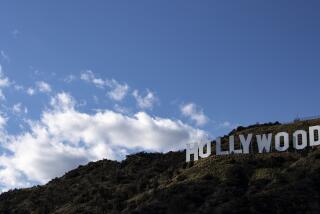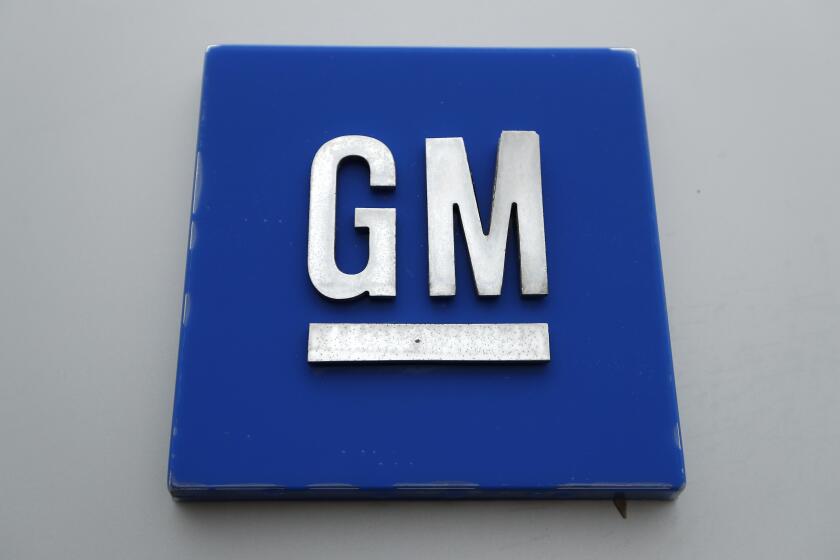Studio owners revise plans for $1-billion update of historic Television City

- Share via
The owners of Television City have scaled back their plans to enlarge and modernize the landmark Los Angeles studio where CBS began making shows to broadcast nationwide at the dawn of the television age.
Formerly known as CBS Television City, the studio sits next to popular tourist attractions the Original Farmers Market and the Grove shopping center in the Fairfax district where it has been operating since 1952 as a factory for such hit shows as “All in the Family,” “Sonny and Cher” and “American Idol.”
CBS sold the famous studio for $750 million in 2019 to Hackman Capital Partners, one of the world’s largest movie lot owners and operators. CBS continues to occupy Television City as a tenant.
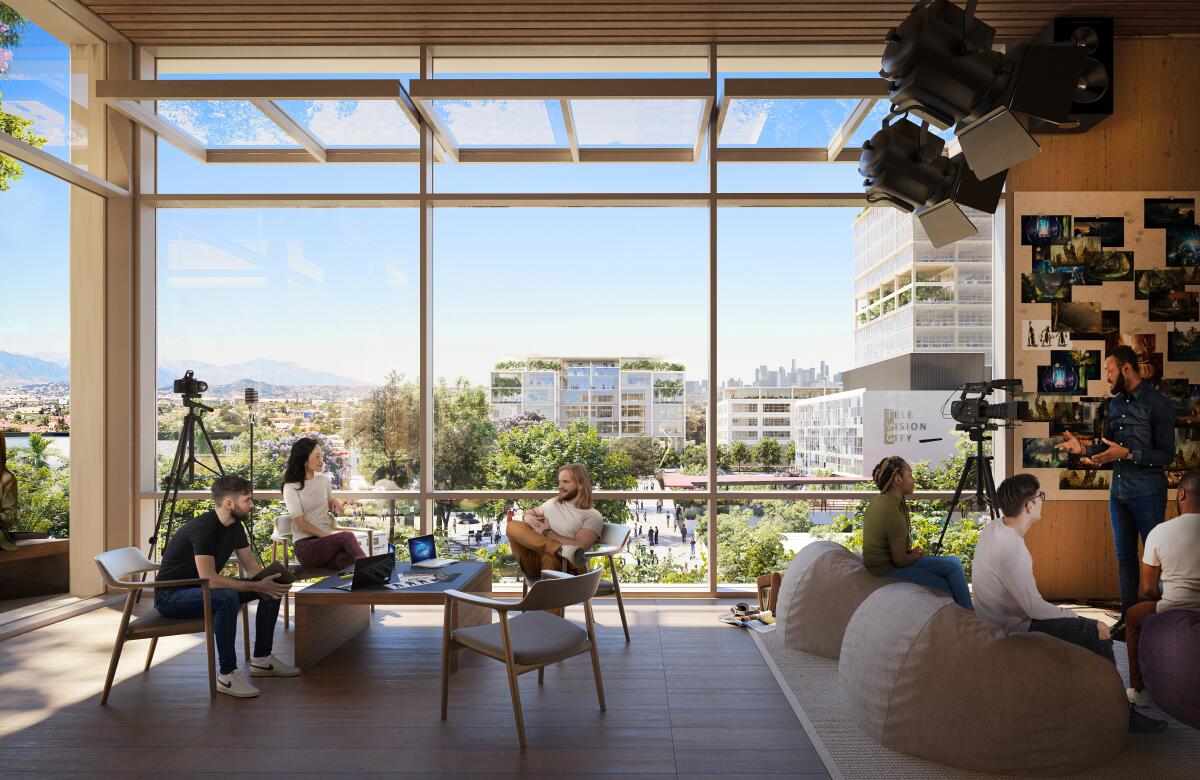
Hackman Capital announced a $1.25-billion plan two years ago to expand and upgrade facilities on the lot at Beverly Boulevard and Fairfax Avenue in hopes of harnessing strong demand in the region for soundstages, production facilities and offices for rent on studio lots.
Hackman Capital on Friday will update its application to the city to enhance the studio, saying it is responding to feedback about the project from nearby residents, stakeholders and city officials. If approved, the new project is expected to be completed by 2028.
The studio owners also brought in a new design architect, Foster + Partners. The London-based firm is led by Norman Foster, a prominent architect whose designs include the pickle-shaped Gherkin skyscraper in London and the master plan for the $2-billion One Beverly Hills condominium and hotel complex under construction in Beverly Hills.
In Beverly Hills, construction is underway on a long-awaited condo and hotel complex valued at nearly $5 billion called One Beverly Hills
Hackman Capital, which operates studios in the U.S., Canada and U.K., is also responding to changing conditions in the office rental market, which has contracted since the COVID-19 pandemic drove many companies to work remotely at least some of the time. Plans still call for creating new offices, but there would be fewer of them.
Foster’s new design eliminates a 15-story office tower on the west side of the lot, cutting 150,000 square feet of offices to rent to entertainment-related firms. Another 15-story office tower remains in the plan, but other building heights have been lowered, particularly along the perimeters, Hackman Capital said.
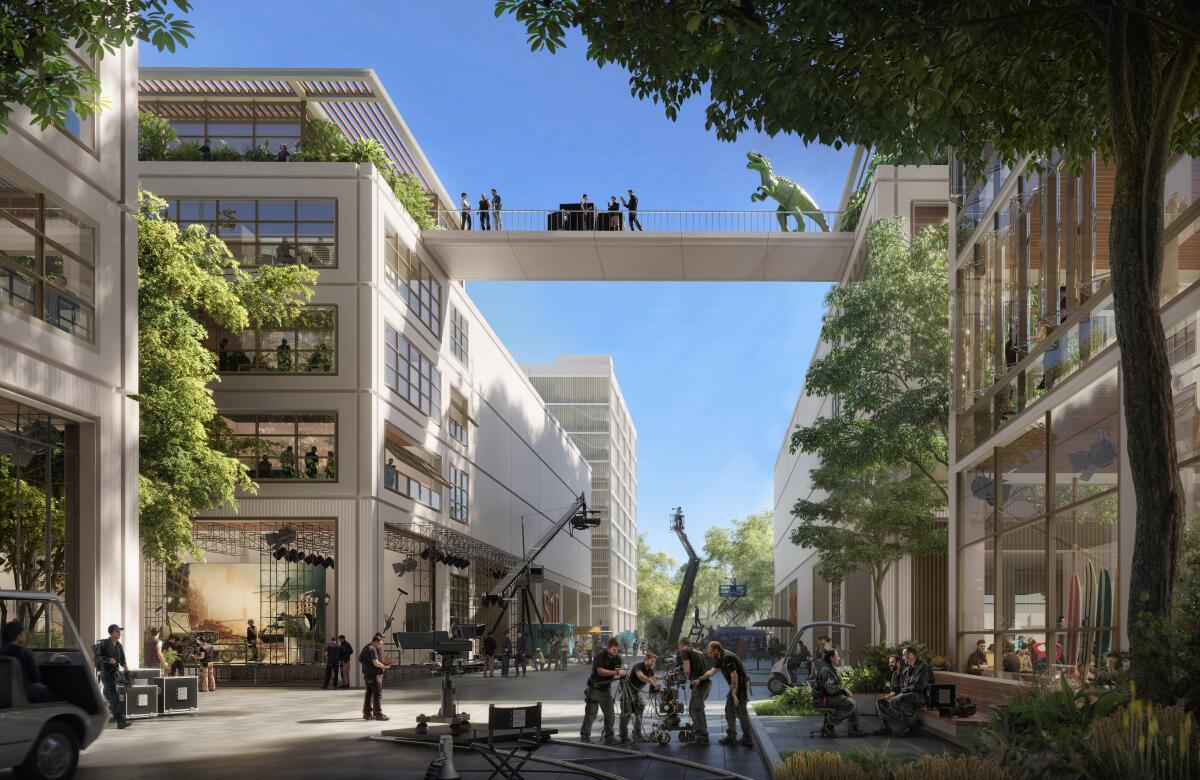
The plan still represents an addition of more than 980,000 square feet to the 25-acre site at Beverly Boulevard and Fairfax Avenue that retains a suburban-style low-density appearance with soundstages, low-rise offices and support facilities flanked by asphalt parking lots.
The company’s proposal calls for combining old and new space to create 700,000 square feet of offices to support production on the lot and an additional 550,000 square feet of offices for rent to entertainment and media companies, the company said.
Office space behind studio gates is in high demand in the Los Angeles area and has been snapped up at other studios by such big Hollywood players as Netflix and Amazon.
“The industry wants to have a location where they can do production and have offices in a self-contained campus environment,” said real estate broker Jeff Pion of CBRE, who represents Hackman Capital. “Having all of the different components that make up production in one location is very attractive to the industry.”
Plans for Television City also call for a new commissary and more than four acres for production base camps. The streetscapes would be improved to be more visually appealing to passersby, with wider sidewalks.
On Fairfax Avenue, where pedestrians now pass by a fenced parking lot, there would be shops and restaurants serving the public on the ground floor of office buildings that could be reached only from inside the lot.
For CBS Corp., the price was right.
The separation is part of the balancing act Hackman Capital is attempting to make Television City feel more friendly to the neighborhood while retaining the security and exclusivity of a closed campus that appeals to celebrities and others who make movies and television shows.
Landlords can also charge a premium for office space on movie lots because they are close to the action for independent production companies and offer the cachet prized by many in the entertainment industry.
Filming activity in Los Angeles has fallen off substantially in the wake of strikes by writers and actors last year, according to FilmLA, a nonprofit organization that tracks on-location shoot days and filming permits in the region. The downward trend compounded a dip that emerged in late 2022 as on-location filming in Los Angeles took a dive as studios pared back movie and TV production that surged during the COVID-19 pandemic.
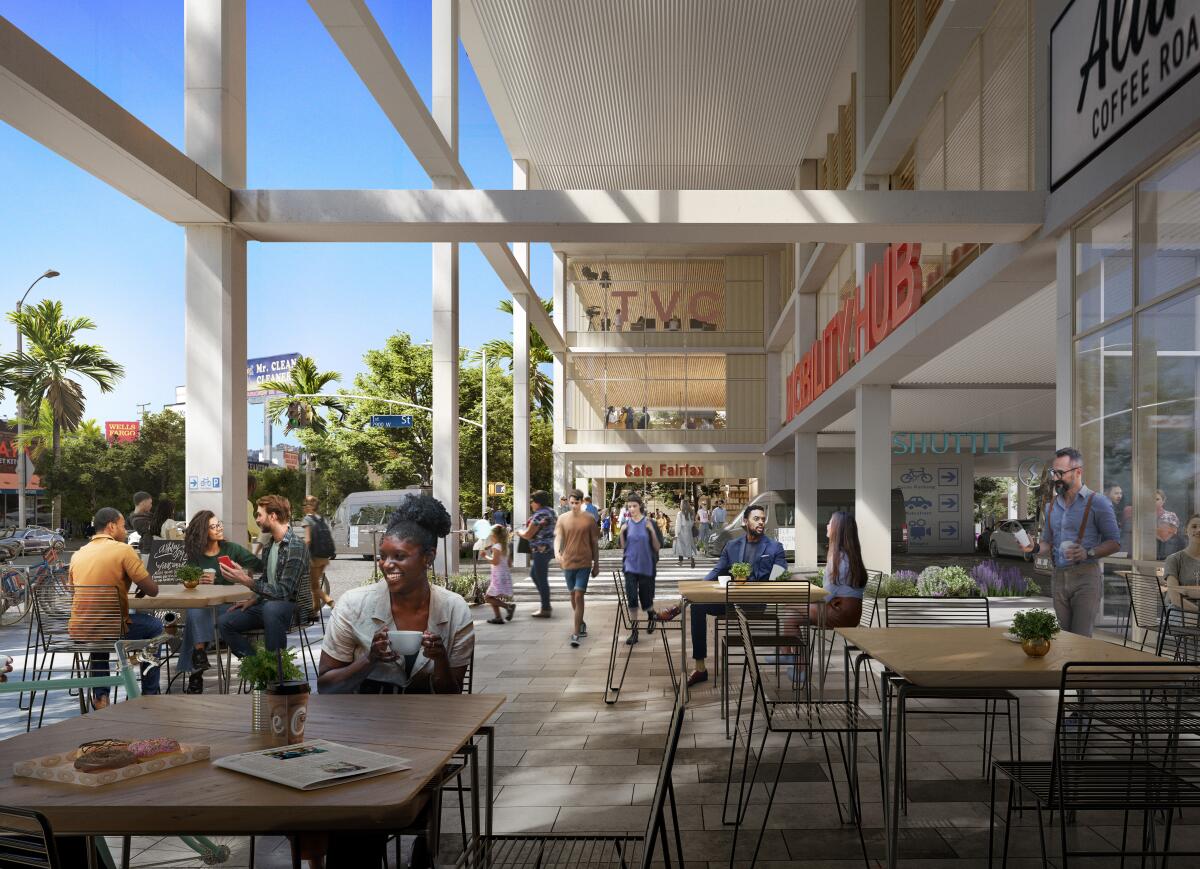
California is finding it particularly hard to rebound from the strikes because it’s more expensive to shoot here, multiple production executives told The Times. That makes Los Angeles less attractive to studios looking to cut costs after major industry disruption.
To Hackman Capital Chief Executive Michael Hackman, the downturn and filming pullback from California suggest that regulators and studio operators should further support production companies.
“Our actual customers tell us all of them want to stay in Los Angeles,” he said. “We have the best crews in the world here, but we don’t have enough modern soundstages in premier locations. We also have to push the state on tax incentives so that we don’t lose business outside of the city.
“The entertainment industry is our city signature industry and if we don’t invest in the future, we’re really at risk of losing it,” Hackman said. “We’re still emerging from a once-in-a-generation dual strike. And the production stoppage cost Angelenos approximately $6.5 billion or more in lost wages and economic activity, which makes it clear how important this industry is to our city, and especially the people who work in entertainment every day.”
Hackman Capital’s proposal calls for raising the number of Television City stages to at least 15, from 8, along with production support facilities.
To make room for the planned additions, parking would be converted from surface lots to garage structures and underground spaces capable of parking 4,930 vehicles.
Two stages built in the 1990s on the east side of the lot would be demolished as part of a planned reconfiguration of the site.
The four original stages built by CBS in 1952 would be preserved along with other historical design elements created by Los Angeles architect William Pereira, who also designed such noteworthy structures as the futuristic Theme Building in the middle of Los Angeles International Airport and the Transamerica Pyramid office tower in San Francisco.
Pereira’s long-range plan for Television City conceived in the 1950s was expansive, said Bob Hale, creative director of Rios, the master plan architect of Hackman Capital’s proposed makeover. Hale said Pereira’s original concept called for the complex to grow to 24 stages and 2.5 million square feet of production space, including several multistory office buildings.
“It was built in a way that it could be disassembled and incrementally extended,” Hale said. “For a number of reasons, that didn’t happen.”
In an effort to make it happen now, Hackman Capital set out to get the support of Councilwoman Katy Yaroslavsky and the surrounding community. Over five years, the company met with nearly 3,000 neighbors, Hackman Capital said.
Among the groups supporting the project are the Holocaust Museum LA, Los Angeles Conservancy, Los Angeles/Orange Counties Building and Construction Trades Council, Mid City West Neighborhood Council and FilmLA, Hackman Capital said.
The first proposal drew fire from neighboring businesses the Grove and Farmers Market, which sent letters to residents in 2022 calling the Television City project a “massively scaled, speculative development which, if approved, would overwhelm, disrupt, and forever transform the community.”
In July 2022, an executive representing Grove owner Rick Caruso appeared before a committee of the Mid City West Neighborhood Council and said the Television City project would create “complex” issues for the neighborhood, including traffic, parking and construction. Caruso himself has said he does not oppose the redevelopment of Television City.
The Beverly Fairfax Community Alliance, which was founded by the Grove and Farmers Market, has been more blunt, warning that the expanded site would clog Fairfax Avenue, Beverly Boulevard, La Brea Avenue and 3rd Street with traffic.
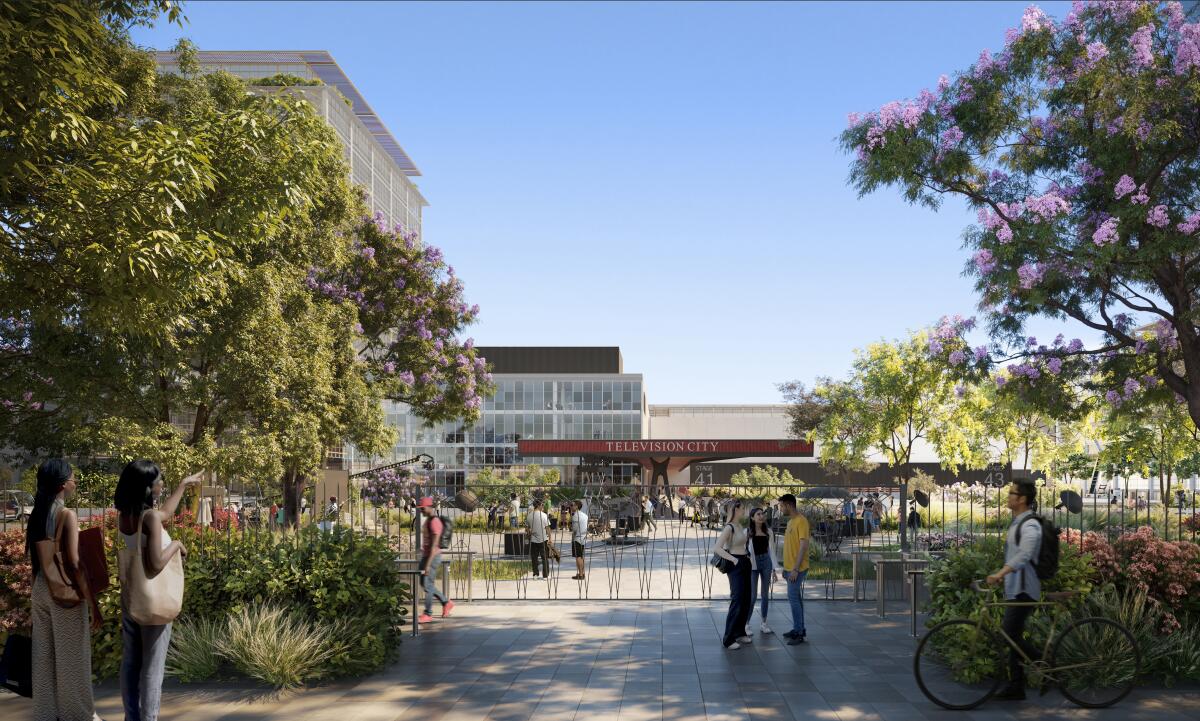
“Even those accustomed to living with L.A. traffic and parking nightmares will be shocked at how much worse it can be,” the group said on its website.
To address such concerns, Hackman Capital said the new plan will reduce the number of estimated daily car trips to Television City by 5,000 to 8,700. The landlord also plans to move its “mobility hub” from The Grove Drive on the east side to Fairfax at 1st Street on the west side of the lot. The mobility hub would serve public transit, rideshares and other passenger drop-offs as well as employee shuttle buses to the subway stop being built at Fairfax and Wilshire Boulevard.
“Our goal with Television City, particularly along the perimeter on our public edges, was to find a really great interface with the community. So it wasn’t just a studio with a blank wall, but we were active and engaged,” said Brian Glodney, a development executive for Hackman Capital.
Community members told Hackman Capital said they want the streets outside the studio to have a sense of connection between mom-and-pop businesses on Fairfax, the Farmers Market, the Grove and Pan Pacific Park, Glodney said.
Outlets on the edge of the lot such as shops and restaurants will be limited to a total of 20,000 square feet, he said, “just enough to help activate the streets but not compete with our neighbors.”
More to Read
Inside the business of entertainment
The Wide Shot brings you news, analysis and insights on everything from streaming wars to production — and what it all means for the future.
You may occasionally receive promotional content from the Los Angeles Times.



